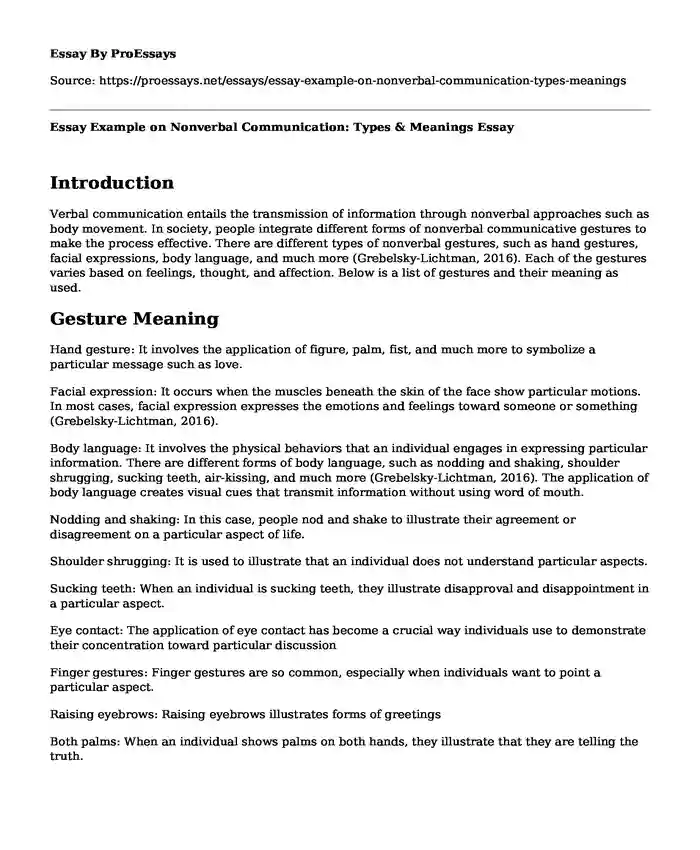Introduction
Verbal communication entails the transmission of information through nonverbal approaches such as body movement. In society, people integrate different forms of nonverbal communicative gestures to make the process effective. There are different types of nonverbal gestures, such as hand gestures, facial expressions, body language, and much more (Grebelsky-Lichtman, 2016). Each of the gestures varies based on feelings, thought, and affection. Below is a list of gestures and their meaning as used.
Gesture Meaning
Hand gesture: It involves the application of figure, palm, fist, and much more to symbolize a particular message such as love.
Facial expression: It occurs when the muscles beneath the skin of the face show particular motions. In most cases, facial expression expresses the emotions and feelings toward someone or something (Grebelsky-Lichtman, 2016).
Body language: It involves the physical behaviors that an individual engages in expressing particular information. There are different forms of body language, such as nodding and shaking, shoulder shrugging, sucking teeth, air-kissing, and much more (Grebelsky-Lichtman, 2016). The application of body language creates visual cues that transmit information without using word of mouth.
Nodding and shaking: In this case, people nod and shake to illustrate their agreement or disagreement on a particular aspect of life.
Shoulder shrugging: It is used to illustrate that an individual does not understand particular aspects.
Sucking teeth: When an individual is sucking teeth, they illustrate disapproval and disappointment in a particular aspect.
Eye contact: The application of eye contact has become a crucial way individuals use to demonstrate their concentration toward particular discussion
Finger gestures: Finger gestures are so common, especially when individuals want to point a particular aspect.
Raising eyebrows: Raising eyebrows illustrates forms of greetings
Both palms: When an individual shows palms on both hands, they illustrate that they are telling the truth.
Summary
Gestures give people a visual body action that assists in communicating a particular message. The kind of movement an individual deploy express different messages (Grebelsky-Lichtman, 2016). In this case, gestures assist individuals to effectively communicate their feelings, thought, understanding, and much more toward particular information (Poupyrev et al., 2020). For instance, showing both palms help an individual to show that all the information they are sharing is pure truth. The symbolic approach helps to effectively demonstrate individuals’ feelings toward a particular notion.
Conclusion
The application of gestures allows people to send a strong message. For instance, facial expression helps to illustrate emotions toward a particular aspect (Poupyrev et al., 2020). As such, it is easier for individuals to build trust, thus creating a powerful connection between those involved (Grebelsky-Lichtman, 2016). Building trust assists individuals in creating a good communicating environment (Poupyrev et al., 2020). In some cases, the approach adds interest to the message, thus promoting good communication.
In some cases, nodding and shaking, especially the head, are deployed to illustrate dissatisfaction in particular aspects. When such a gesture is deployed, it becomes easier for individuals to conceptually understand the information (Grebelsky-Lichtman, 2016). Therefore, the gesture helps to avoid any form of conflicting ideas as it clearly illustrates the side that individual support (Poupyrev et al., 2020). Nodding and shoulder shruggings are perceived as manual communicative gestures as they symbolize particular aspects of information (Grebelsky-Lichtman, 2016). Symbolism highly influences individuals' understanding, thus promoting their ability to share information (Poupyrev et al., 2020). When a gesture is associated with a particular sign, it becomes easier for an individual to effectively understand the primary focus, thus promoting the connectivity.
References
Grebelsky-Lichtman, T. (2016). An advanced framework for verbal communication and nonverbal gestures in parent-child interactions. Studies in Media and Communication, 4(1), 82-98. file:///E:/1623-8040-1-PB.pdf
Poupyrev, I., Schwesig, C., Schulze, J., Arnall, T., & Bishop, D. G. B. (2020). Gesture detection and interactions. https://patentimages.storage.googleapis.com/98/15/1e/fe94f3b7c9d2ec/US10572027.pdf
Cite this page
Essay Example on Nonverbal Communication: Types & Meanings. (2023, Sep 10). Retrieved from https://proessays.net/essays/essay-example-on-nonverbal-communication-types-meanings
If you are the original author of this essay and no longer wish to have it published on the ProEssays website, please click below to request its removal:
- Sociology Essay Example: Interracial Relationships
- Science, Technology and Ethics - Argumentative Essay Sample
- Essay Sample on Cultural Taboos
- Essay Example on Government: A Powerful Social Institution Powering Society
- Essay on Activism for Social Change: The Civil Rights, WLM & Gay Rights Movements
- Paper Example on Group Dynamics: Understanding Interactions for Successful Change
- Essay Sample on Gaining Investors: Effective Communication for Success







